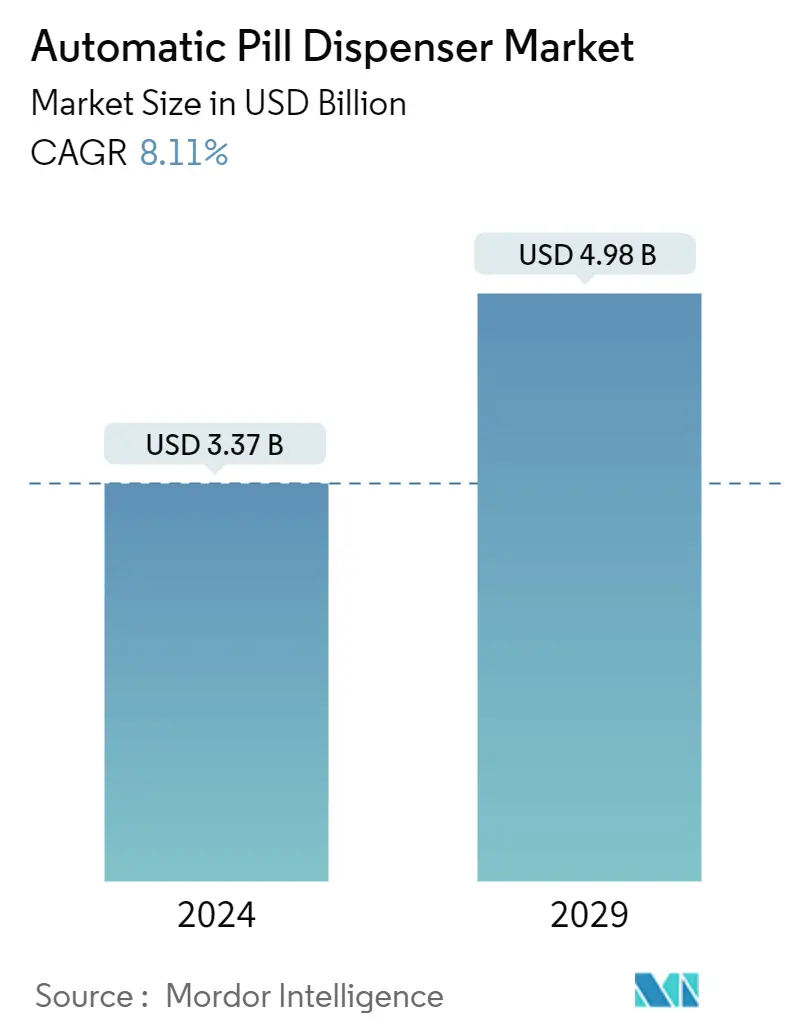Market Size of Automatic Pill Dispenser Industry

| Study Period | 2019-2029 |
| Market Size (2024) | USD 3.37 Billion |
| Market Size (2029) | USD 4.98 Billion |
| CAGR (2024 - 2029) | 8.11 % |
| Fastest Growing Market | Asia-Pacific |
| Largest Market | North America |
Major Players
*Disclaimer: Major Players sorted in no particular order |
Automatic Pill Dispenser Market Analysis
The Automatic Pill Dispenser Market size is estimated at USD 3.37 billion in 2024, and is expected to reach USD 4.98 billion by 2029, growing at a CAGR of 8.11% during the forecast period (2024-2029).
COVID-19 led to a significant impact on the use of automated pill dispensers. The rising need for less human interaction boosted the demand for the product. For instance, according to the study published in the International Journal of Science Engineering and Technology, the major objective of the dispensing machine is to make medicine available to users around the clock so that it may assist villagers who live far from a hospital or clinic in purchasing medication. The increased workload in hospitals, the increased responsibility for patient satisfaction, and the effective dispensing time for single medications have a positive impact on the growth of the global automatic pill dispenser market in the forthcoming years. Furthermore, the market has seen a significant surge post-pandemic due to the rising importance of automated pill dispensers and rising awareness about medication adherence in the elderly as an automated pill system is a simple wearable gadget to set up and can dispense tablets to elderly post-covid patients who need assistance taking their medications.
The studied market growth is predominantly contributed by factors such as the growing burden of diseases, technological advancements in healthcare, and the increasing elderly population across the globe. Due to the changing lifestyle pattern, diseases are increasing largely among the population. For instance, 2021 WHO Global Health Estimates 2021 reported the top ten global causes of Disability-Adjusted Life Years (DALYs) were neonatal conditions, ischaemic heart disease, stroke, lower respiratory infections, diarrhoeal diseases, road injury, chronic obstructive pulmonary disease, diabetes mellitus, tuberculosis, and congenital anomalies. Also, there has been the greatest increase in death in females around threefold due to dementia and Alzheimer’s over the past two decades, with around 80% more deaths and 70% more DALYs in females than males due to these neurological diseases.
With the increasing cases of Alzheimer's and dementia, there are increased chances of missing doses of medication or wrong administration of it, hence increasing the need for an automatic pill dispenser. For another instance, in 2022 Alzheimer's Association reported that more than 6 million Americans lived with Alzheimer's, and this number is expected to increase by 13 million by 2050. Alzheimer's is a chronic disorder associated with depression, memory loss, and other physiological issues in the geriatric population, thereby increasing the patient's visits to hospitals; thus, concerning the above-mentioned facts, the automatic pill dispenser market is expected to show lucrative growth over the forecast period.
The elderly population is increasing across the world and is largely affected by some kind of chronic disease. With increasing age, forgetfulness becomes very common in geriatric people, so it becomes a challenge to keep on track with the medications. Moreover, the United Nations, Department of Economic and Social Affairs (UNDESA), World Population Ageing Highlights, 2022 stated that in 2022, there were 771 million people in the world aged 65 or over and which is projected to be 994 million in 2030 and 1.6 billion by 2050. Thus, the increasing aging is leading to an increased burden of chronic diseases all over the globe, and the need for care drives the automatic pill dispenser market.
Moreover, the other factors associated with the growth of the automatic pill dispenser market, like technological adoptions in healthcare, also participate in the growth. However, the cost associated with automatic pill dispensers may hamper the growth of the market.
Automatic Pill Dispenser Industry Segmentation
As per the scope of the report, the automatic pill dispenser is an advanced, high-tech solution that helps the patient with medication management and adherence. The automated pill dispenser can be portable or non-portable, allowing one to organize medicines according to the scheduled time. These devices ensure the dispensing of the correct pills via reminder alarms. Dispensing cabinets are used in hospitals and healthcare settings. These can be centralized or decentralized automated pill dispenser systems. The decentralized systems can be used at the point of care units in resident care units other than pharmacies.
The automatic pill dispenser market is segmented by type (centralized automatic dispensers (carousels and robotics) and decentralized automatic dispenser systems (ward-based automated dispenser systems, pharmacy-based automated dispenser systems, and automated unit dose dispenser systems), indications (physical disability, neurodegenerative disorders, dementia, and other indications), end users (hospitals, pharmacies, and home healthcare), and geography (North America, Europe, Asia-Pacific, the Middle East, Africa, and South America). The report also covers the estimated market sizes and trends for 17 countries across major regions globally.
The report offers the value (in USD) for the above segments.
| By Type | |||||
| |||||
|
| By Indication | |
| Physical Disability | |
| Neurodegenerative Disorders and Dementia | |
| Other Indications |
| By End-User | |
| Hospitals | |
| Pharmacy | |
| Home Healthcare |
| Geography | ||||||||
| ||||||||
| ||||||||
| ||||||||
| ||||||||
|
Automatic Pill Dispenser Market Size Summary
The automatic pill dispenser market is poised for significant growth, driven by the increasing demand for efficient medication management solutions. The market is experiencing a surge in interest due to the rising need for less human interaction, particularly highlighted during the COVID-19 pandemic. This demand is further fueled by the growing elderly population and the prevalence of chronic diseases, which necessitate reliable medication adherence solutions. Technological advancements in healthcare are also contributing to market expansion, as automated pill dispensers offer a simple and effective way to assist patients, especially those with conditions like Alzheimer's and dementia, in managing their medication schedules. The market is characterized by the adoption of decentralized systems that enhance medication storage and distribution, reducing the likelihood of prescription errors and improving overall patient care.
North America holds a significant share of the automatic pill dispenser market, supported by the region's acceptance of advanced healthcare solutions and a rapidly growing geriatric population. The presence of major market players and strategic partnerships further bolster the market's growth prospects. These partnerships aim to enhance medication management and patient safety, particularly in remote settings. The market is moderately competitive, with key players like Becton Dickinson and Company, Omnicell, and McKesson Corporation leading the charge. As the demand for automated medication management solutions continues to rise, driven by the increasing burden of chronic diseases and lifestyle changes, the automatic pill dispenser market is expected to witness robust growth over the forecast period.
Automatic Pill Dispenser Market Size - Table of Contents
-
1. MARKET DYNAMICS
-
1.1 Market Overview
-
1.2 Market Drivers
-
1.2.1 Increasing Elderly Population Along with Growing Burden of Diseases
-
1.2.2 Technological Advancement in Healthcare
-
-
1.3 Market Restraints
-
1.3.1 High Costs Associated with Automatic Pill Dispenser
-
-
1.4 Porter's Five Forces Analysis
-
1.4.1 Bargaining Power of Suppliers
-
1.4.2 Bargaining Power of Buyers/Consumers
-
1.4.3 Threat of New Entrants
-
1.4.4 Threat of Substitute Products
-
1.4.5 Intensity of Competitive Rivalry
-
-
-
2. MARKET SEGMENTATION
-
2.1 By Type
-
2.1.1 Centralized Automatic Dispenser
-
2.1.1.1 Carousels
-
2.1.1.2 Robotic
-
-
2.1.2 Decentralized Automatic Dispenser
-
2.1.2.1 Ward Based Automated Dispensing System
-
2.1.2.2 Pharmacy Based Automated Dispensing System
-
2.1.2.3 Automatic Unit Dose Dispensing System
-
-
-
2.2 By Indication
-
2.2.1 Physical Disability
-
2.2.2 Neurodegenerative Disorders and Dementia
-
2.2.3 Other Indications
-
-
2.3 By End-User
-
2.3.1 Hospitals
-
2.3.2 Pharmacy
-
2.3.3 Home Healthcare
-
-
2.4 Geography
-
2.4.1 North America
-
2.4.1.1 United States
-
2.4.1.2 Canada
-
2.4.1.3 Mexico
-
-
2.4.2 Europe
-
2.4.2.1 Germany
-
2.4.2.2 United Kingdom
-
2.4.2.3 France
-
2.4.2.4 Italy
-
2.4.2.5 Spain
-
2.4.2.6 Rest of Europe
-
-
2.4.3 Asia-Pacific
-
2.4.3.1 China
-
2.4.3.2 Japan
-
2.4.3.3 India
-
2.4.3.4 Australia
-
2.4.3.5 South Korea
-
2.4.3.6 Rest of Asia-Pacific
-
-
2.4.4 Middle East and Africa
-
2.4.4.1 GCC
-
2.4.4.2 South Africa
-
2.4.4.3 Rest of Middle East and Africa
-
-
2.4.5 South America
-
2.4.5.1 Brazil
-
2.4.5.2 Argentina
-
2.4.5.3 Rest of South America
-
-
-
Automatic Pill Dispenser Market Size FAQs
How big is the Automatic Pill Dispenser Market?
The Automatic Pill Dispenser Market size is expected to reach USD 3.37 billion in 2024 and grow at a CAGR of 8.11% to reach USD 4.98 billion by 2029.
What is the current Automatic Pill Dispenser Market size?
In 2024, the Automatic Pill Dispenser Market size is expected to reach USD 3.37 billion.

